Independent GovERP Reuse Assessment Appendices
-
Appendix A: Terms of reference
Context
New APS ERP approach
On 28 November 2023, the Finance Minister, Senator the Hon Katy Gallagher, announced the new Enterprise Resource Planning (ERP) approach for the Australian Public Service (APS) that replaces the Shared Services Transformation Program. This new approach sets the strategic direction for APS ERP system management, which is underpinned by the principles of choice, market competition, and affordability. As part of the announcement, an independent assessment (the Assessment) will evaluate the suitability of Services Australia
ERP (GovERP) use by Services Australia, and reuse by Commonwealth entities to support Commonwealth entities to implement future cost-effective ERP uplifts.
Independent Reuse Assessment
The Assessment will be led by an independent eminent person(s), with support from a Secretariat with expertise drawn from the DTA, and experts from across the APS and the private sector, to evaluate work undertaken to date to deliver GOVERP.
Term
The Assessment will be completed by 30 June 2024.
Objectives
The Assessment will focus on the following areas to leverage work already completed, draw out lessons learned, and uncover opportunities for reuse of GOVERP to support the new APS ERP approach. The objectives of the Assessment are to:
- Evaluate and understand what has been delivered to date.
- Evaluate and understand what has been spent to date against what has been delivered.
- Evaluate and understand the suitability of delivered outputs for reuse across the Commonwealth.
- Contribute standard designs, patterns and other related guidance to the Australian Government Architecture.
- Articulate recommendations and guidance for reuse including information that will support entities to plan future ERP uplifts.
- Advise on potential costs, risks, and associated benefits, to carry out any remaining work envisaged by Services Australia to complete GovERP.
- Advise on potential ongoing costs to entities from reusing GovERP, if reuse can be supported.
- Identify alternative designs and pathways that might provide more cost-effective options for any remaining work.
- Identify any existing ‘readymade’ deployment configurations deemed suitable to allow direct onboarding of entities.
Deliverables
The Assessment will produce a report, and where relevant, industry standard reference materials that will be made available through the Australian Government Architecture. A draft report will be provided to the Minister by 31 May 2024 with the final report provided by 30 June 2024. Secretaries Data and Digital, and the Digital Leaders, Committees will be provided progressive updates on the Assessment.
Summary of how terms of reference have been addressed in this report TOR Related Report Section 1. Evaluate and understand what has been delivered to date. Section 3.2 Delivery to date 2. Evaluate and understand what has been spent to date against what has been delivered. Section 3.1 Expenditure to date 3. Evaluate and understand the suitability of delivered outputs for reuse across the Commonwealth. Section 4 Reuse assessment 4. Contribute standard designs, patterns and other related guidance to the Australian Government Architecture. Reusable business process maps, designs, patterns, and related documentation have been identified as potential Australia Government Architecture contributions. 5. Articulate recommendations and guidance for reuse including information that will support entities to plan future ERP uplifts. Section 1.1 Summary of recommendations 6. Advise on potential costs, risks, and associated benefits, to carry out any remaining work envisaged by Services Australia to complete GovERP. Section 3.3 Remaining work to complete GovERP 7. Advise on potential ongoing costs to entities from reusing GovERP, if reuse can be supported. Section 4.2 Potential ongoing reuse costs to entities 8. Identify alternative designs and pathways that might provide more cost-effective options for any remaining work. Section 5 Alternate designs or delivery pathways 9. Identify any existing ‘readymade’ deployment configurations deemed suitable to allow direct onboarding of entities. Section 4.1 Reusability by tier (4.1.1 Tier 1 reuse opportunities)
-
Appendix B: Eminent Panel biographies
Ms Maile Carnegie

Maile is Group Executive Australia Retail, ANZ’s largest business which serves around five million retail customers through an extensive network of branches, ATMs and leading online and mobile banking applications and digital solutions. Since joining ANZ, she has been developing enterprise-wide digital capability, including
the transformation of the Australia Business which aims to improve the financial wellbeing of ANZ customers. Maile also holds Group accountability for design and marketing which includes ANZ’s brand, advertising and sponsorships. She is a Non-Executive Director on the Board of ANZ Bank New Zealand Limited.
Maile is keenly focused on customer centric innovation and design. She joined ANZ in 2016 from Google where she was Managing Director Australia and New Zealand. She also spent over 20 years with Proctor and Gamble in roles including Managing Director Australia and New Zealand, General Manager for Asia Strategy, Marketing and Design based in Singapore and a number of senior commercial roles in the United States.
With a passion for helping future generations, Maile contributed as one of six members on the independent review of the Australian Public Service, was previously Vice-Chair of the ASIC External Advisory Panel and a board member of Innovation and Science Australia. She is currently a member of the Board at University of Technology, Sydney and a Trustee of the Australian Museum.
Maile holds a degree in Business Administration in Finance, Economics and Marketing from the University of Technology Sydney.
Ms Catherine D’Elia

Catherine is a senior executive with an excellent track record in leading people centred, innovative, strategic, service-oriented solutions, leveraging technology, transforming culture and streamlining processes across geographies.
With a strong background in strategic leadership, large scale change management, executive level collaboration, Catherine has a proven track record in fostering a positive work environment, complex problem resolution, and internal and external relationship management.
Catherine has held senior positions in the NSW public service for the last 16 years, including as a Deputy Secretary in the Department of Communities and Justice Department. Prior to joining the public service, Catherine held senior positions in the banking sector at NAB and Citizens Bank in the US.
Catherine holds a Masters in Education, Human Resource Development from Boston University, as well as a Bachelor of Arts in International Relations from the University of New Hampshire.
Mr Chris Cawood

Chris has over 30 years’ leadership and technical experience across heavy industry sectors including manufacturing, oil and gas, mining and transport.
Chris joined Ixom in late 2021 and was previously the Chief
Information Officer of OceanaGold for eight years. Prior to this he had an extensive career with BHP, where he held CIO roles in various business units.
Chris developed a passion for technology transformation and change in his early career in the BHP Steel (now BlueScope) marketing team. From there, he progressed into leadership roles with the BHP Petroleum division in Western Australia and for five years was involved in the expansion of its oil and gas assets. He was appointed to CIO roles in the coal and marketing divisions of BHP and was responsible for large technology transformation projects as well as a number of M&A integrations and divestments.
Chris has significant experience working in multicultural environments and with diverse teams. He has lived in Europe and worked closely with colleagues and external stakeholders in Pakistan, Japan, China, Africa, Singapore, The Philippines and North America.
Chris holds a Bachelor of Science and Education degree from Melbourne University.
Mr Chris Fechner

Chris Fechner was appointed the Chief Executive Officer at the Digital Transformation Agency on 13 October 2021.
Chris is also the Head of the Digital Profession; he started his two-year term in January 2023.
Chris has extensive experience in state government
services, focusing on large scale digital and ICT reform and transformation programs as well as implementing contemporary investment, contestability, and governance frameworks.
Before joining the Australian Public Service, Chris was the Queensland Government Chief
Customer and Digital Officer throughout 2020 and 2021. Chris was previously the Chief Digital and Product Officer at Service NSW. Prior to that, Chris held a number of senior positions across the NSW and Queensland governments as well as in freight and rail organisations.
Chris holds an Executive Masters of Business Administration and a Bachelor of Applied Science and Computing, both from the Queensland University of Technology.
As CEO, Chris is responsible for leading the agency to ensure we deliver on the government’s digital transformation agenda, in accordance with our agency’s executive order and the Public Governance, Performance and Accountability Act 2013.
-
Appendix C: Technical assessment report
Appendix C can be found on digital.gov.au together with this Eminent Panel report.
There is also a download link for a PDF on the Enterprise Resource Planning landing page.
-
Appendix D: Stakeholders engaged
ERP Consultative Committee member entities:
- ACT Government
- Attorney-General’s Department
- Australian Bureau of Statistics
- Australian Taxation Office
- Department of Defence
- Department of Employment and Workplace Relations
- Department of Finance
- Department of Foreign Affairs and Trade
- Department of Health and Aged Care
- Department of Home Affairs
- Services Australia.
Note: These entities were also represented in the Assessment’s interviews and working group.
-
Appendix E: Key reuse assessment-related correspondence
Correspondence from DTA CEO to Services Australia CEO, 20 May 2024 sharing preliminary observations and insights of the Assessment
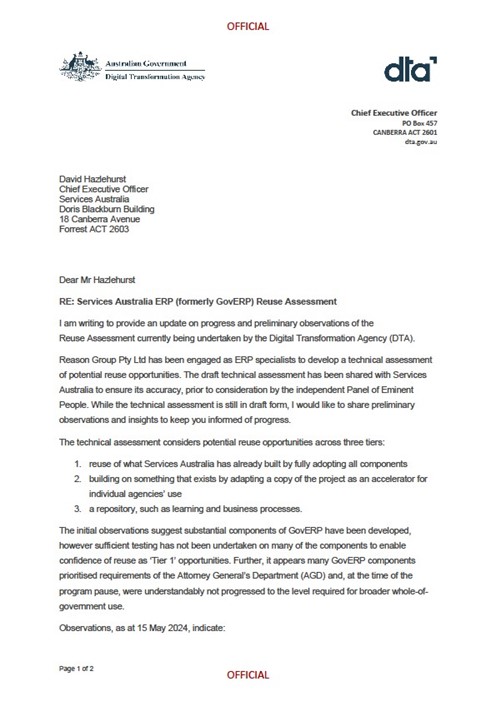
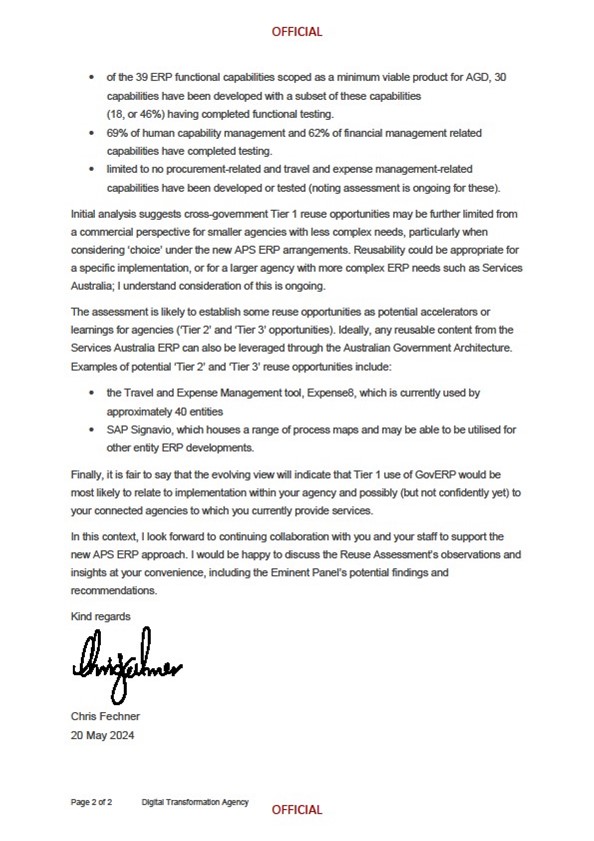
Correspondence from the Minister for Government Services to the Minister for Finance, 26 April 2024 providing an update on the GovERP program
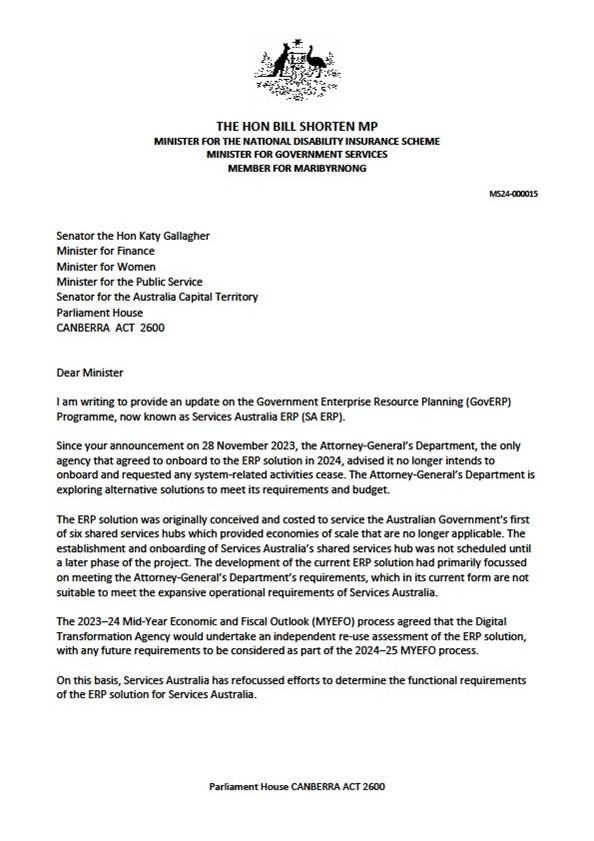

-
Accessible Appendix E: Key reuse assessment-related correspondence
Correspondence from DTA CEO to Services Australia CEO, 20 May 2024 sharing preliminary observations and insights of the Assessment
This letter appears on Digital Transformation Agency letterhead and comes from the CEO.
Dear Mr Hazlehurst,
RE: Services Australia ERP (formerly GovERP Reuse Assessment)
I am writing to provide an update on progress and preliminary observations of the Reuse Assessment currently being undertaken by the Digital Transformation Agency (DTA).
Reason Group Pty Ltd has been engaged as ERP specialists to develop a technical assessment of potential reuse opportunities. The draft technical assessment has been shared with Services Australia to ensure its accuracy, prior to consideration by the independent Panel of Eminent People. While the technical assessment is still in draft form, I would like to share preliminary observations and insights to keep you informed of progress.
The technical assessment considers potential reuse opportunities across three tiers:
- reuse of what Services Australia has already built by fully adopting all components
- building on something that exists by adapting a copy of the project as an accelerator for individual agencies' use
- a repository, such as learning and business processes.
The initial observations suggest substantial components of GovERP have been developed, however sufficient testing has not been undertaken on many of the components to enable confidence of reuse as 'Tier 1' opportunities. Further, it appears many GovERP components prioritised requirements of the Attorney General's Department (AGD) and, at the time of the program pause, were understandably not progressed to the level required for broader whole-of-government use.
Observations, as at 15 May 2024, indicate:
- of the 39 ERP functional capabilities scoped as a minimum viable product for AGD, 30 capabilities have been developed with a subset of these capabilities (18, or 46%) having completed functional testing.
- 69% of human capability management and 62% of financial management related capabilities have completed testing.
- limited to no procurement-related and travel and expense management-related capabilities have been developed or tested (noting assessment is ongoing for these).
Initial analysis suggests cross-government Tier 1 reuse opportunities may be further limited from a commercial perspective for smaller agencies with less complex needs, particularly when considering 'choice' under the new APS ERP arrangements. Reusability could be appropriate for a specific implementation, or for a larger agency with more complex ERP needs such as Services Australia; I understand consideration of this is ongoing.
The assessment is likely to establish some reuse opportunities as potential accelerators or learnings for agencies ('Tier 2' and 'Tier 3' opportunities). Ideally, any reusable content from the Services Australia ERP can also be leveraged through the Australian Government Architecture. Examples of potential 'Tier 2' and 'Tier 3' reuse opportunities include:
- the Travel and Expense Management tool, Expense8, which is currently used by approximately 40 entities
- SAP Signavio, which houses a range of process maps and may be able to be utilised for other entity ERP developments.
Finally, it is fair to say that the evolving view will indicate that Tier 1 use of GovERP would be most likely to relate to implementation within your agency and possibly (but not confidently yet) to your connected agencies to which you currently provide services.
In this context, I look forward to continuing collaboration with you and your staff to support the new APS ERP approach. I would be happy to discuss the Reuse Assessment's observations and insights at your convenience, including the Eminent Panel’s potential findings and recommendations.
Kind regards
Chris Fechner
20 May 2024
Correspondence from the Minister for Government Services to the Minister for Finance, 26 April 2024 providing an update on the GovERP program
This letter appears on The Hon Bill Shorten MP's letterhead
The address on this letter reflects that it is written to Senator the Hon Katy Gallagher
Dear Minister
I am writing to provide an update on the Government Enterprise Resource Planning (GovERP) Programme, now known as Services Australia ERP (SA ERP).
Since your announcement on 28 November 2023, the Attorney-General’s Department, the only agency that agreed to onboard to the ERP solution in 2024, advised it no longer intends to onboard and requested any system-related activities cease. The Attorney-General’s Department is exploring alternative solutions to meet its requirements and budget.The ERP solution was originally conceived and costed to service the Australian Government’s first of six shared services hubs which provided economies of scale that are no longer applicable. The establishment and onboarding of Services Australia’s shared services hub was not scheduled until a later phase of the project. The development of the current ERP solution had primarily focussed on meeting the Attorney-General’s Department’s requirements, which in its current form are not suitable to meet the expansive operational requirements of Services Australia.
The mid 2023–2024 Mid-Year Economic and Fiscal Outlook (MYEFO) process agreed that the Digital Transformation Agency would undertake an independent re-use assessment of the ERP solution, with any future requirements to be considered as part of the 2024–25 MYEFO process.
On this basis, Services Australia has refocused efforts to determine the functional requirements of the ERP solution for Services Australia.
In February 2023, you agreed to reprofile $60 million of Services Australia’s original GovERP budget allocation to the 2023–24 financial year. As at 31 March 024, the Programme has spent $38.2 million of the Agency’s 2023-24 budget. The remaining budget will be used to continue sustainment of the current ERP solution, including ongoing licencing and hosting costs of the platform.
Yours sincerely
Bill Shorten
26 April 2024
-
Appendix F: MVP capabilities for GovERP
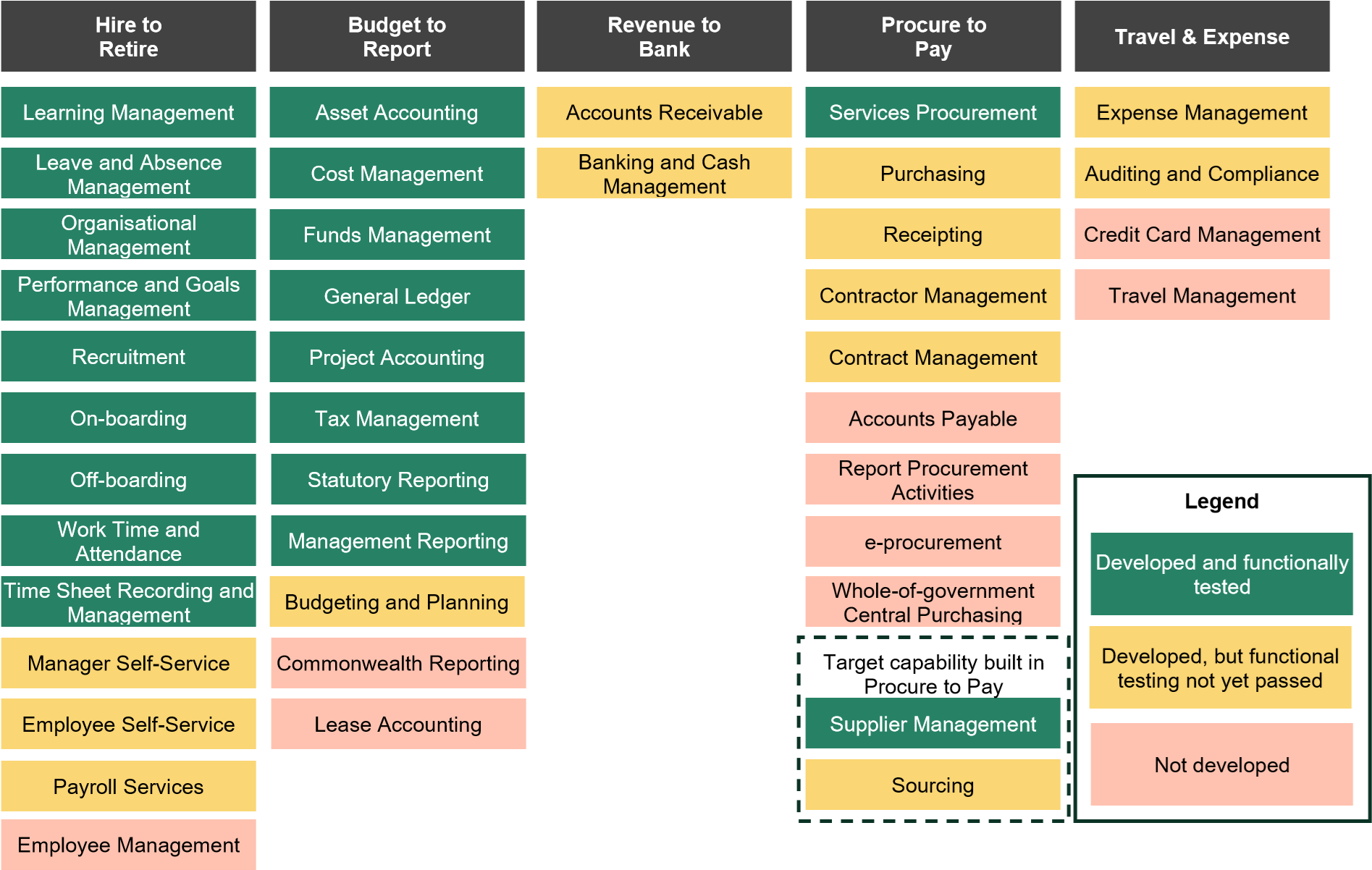
Shared Services Steering Committee-agreed MVP 1.0 capabilities for whole-of-government purposes The above table is a list of capabilities grouped by value stream.
Within this set of capabilities, a scope for initial delivery (MVP) and target state were both defined, as reflected in the blue and purple respectively. Capabilities marked with a star are those Extended Capabilities that were to be considered for inclusion in the scope of Shared Services.
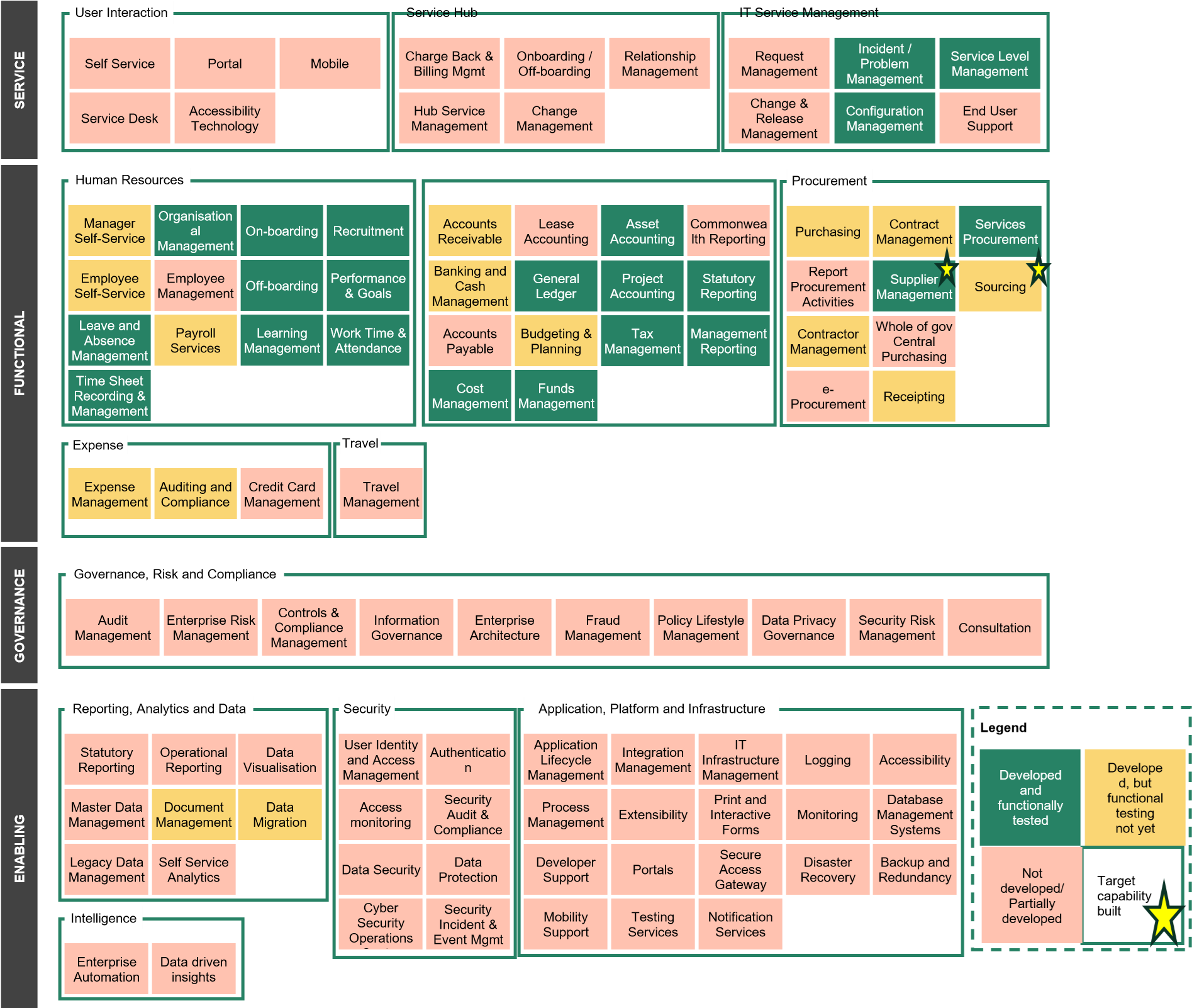
Services Australia-developed MVP1.1 functional capabilities A brief description of each of the MVP1.1 functional capabilities is below.
Capability Description Hire to Retire (H2R) Learning management This capability relates to administration, documentation, tracking, reporting, and delivery of educational courses, training programs, or learning and development initiatives within an entity Leave and absence management Processes and systems used by an entity to manage employee time off, including vacation, sick leave, and other types of absences Organisational management Process of planning, coordinating, and overseeing the various functions and operations within an entity Performance and goals management Setting, tracking, and evaluating employee performance against established goals and objectives Recruitment Process of identifying and attracting candidates to fill job vacancies within the entity including the entire hiring process, from inception to the individual recruit's integration into the entity On-boarding Integration of new employees into an entity Off-boarding The process of managing the departure of an employee from an entity Work time and attendance Systems used by entities of all sizes, across the APS, to ensure accuracy of employee's time and attendance, pay and absence requests Time sheet recording and management Tracking and managing employee work hours and attendance Capability Description Manager self service Enables managers to access personnel data for their direct reports, such as leave, time-off, performance, and learning information. Employee self service System that supports employees to access and manage their own personal and employment-related information Payroll services Administration of an entity's employee's financial records including salaries, wages, bonuses, deductions, and net pay Employee management Processes, systems, and practices used by an entity to manage its workforce Budget to Report (B2R) Asset accounting Sub-ledger that records the financial transactions related to an entities’ assets Cost management Planning, estimating, budgeting, and controlling costs in a project or business operation Funds management Managing and overseeing the financial resources of an entity General ledger Complete record of all financial transactions over the life of an entity Project accounting Financial transactions related to managing a project including costs, billing, and revenue Tax management Management of an entity’s tax obligations to ensure Australian tax laws and regulations compliance Statutory reporting The mandatory submission of financial and non-financial information by an entity to the australian government or regulatory bodies Management
reporting
Provision of information to managers, to assist with informed decisions including tracking progress or KPI’s, identifying trends, and highlighting areas that may require attention or improvement Budgeting and planning The process of creating a detailed financial plan for an entities’ future expenses and revenues Commonwealth
reporting
Mandatory reporting requirements for Australian Government entities to prepare and submit financial statements, performance reports, and other information to the government in accordance with relevant legislation and accounting standards Lease accounting The accounting treatment of leases, which are contractual agreements between a lessee and a lessor for the use of an asset Revenue to Bank (R2B) Accounts receivable Funds that customers owe for products or services that have been invoiced Banking and cash management The operational and banking processes associated with the collection, aggregation, holding and disbursement of cash Procure to Pay (P2) Service procurement The process of acquiring services from vendors including preparing RFTs/RFQs, managing purchasing and contract lifecycles, sourcing, requisition, order processing, payments and reporting Purchasing Purchase of goods and/or services by an entity Capability Description Receipting The process of recording and acknowledging the receipt of goods, services, or payments Contractor management Management of the relationship between an entity and its contractors Contract management Process of managing legally binding agreements including creation and negotiation, contract execution, contract compliance monitoring and renewal or close out Accounts payable Money owed by the entity to its vendors Report procurement
activities
Reports showing procurement activities, costings and purchasing information regarding goods and/or services e-Procurement Use of electronic methods to conduct transactions between buyers and suppliers Whole-ofgovernment central purchasing Whole-of-government procurement designed for permission-based services as permits, accreditations, licenses, and registrations Supplier
management
Task ensuring suppliers meet the expectations of their contract Sourcing Process of locating products or services outside the entity Travel and Expense Management (TEMs) Expense management Bookkeeping system for controlling, tracking, and processing employee expense reimbursements Auditing and compliance management Measurement of an entity’s adherence to rules and regulations, standards, and any relevant internal bylaws and codes of conduct Credit card
management
Employee-related corporate credit card transactions Travel
management
System used by entities to oversee and facilitate business travel
-
Appendix F: MVP capabilities for GovERP
Shared Services Steering Committee-agreed MVP 1.0 capabilities for whole-of-government purposes
The table above contains the following information:
1. Hire to retire
Developed and functionally tested
• Learning management
• Leave and absence management
• Organisational management
• Performance and goals management
• Recruitment
• On-boarding
• Off-boarding
• Work time and attendance
• Time sheet recording and managementDeveloped, but functional testing not yet passed
• Manager self-service
• Employ self-service
• Payroll services2. Budget to report
Developed and functionally tested
• Asset accounting
• Cost management
• Funds management
• General ledger
• Project accounting
• Tax management
• Statutory reporting
• Management reportingDeveloped, but functional testing not yet passed
• Budgeting and planning
3. Revenue to bank
Developed, but functional testing not yet passed
• Accounts receivable
• Banking and cash management4. Procure to pay
Developed and functionally tested
• Services procurement
Developed, but functional testing not yet passed
• Purchasing
• Receipting
• Contractor management
• Contract management4a. Target capability built in procure to pay
Developed and functionally tested
• Supplier management
Developed, but functional testing not yet passed
- Sourcing
5. Travel & expense
Developed, but functional testing not yet passed
• Expense management
• Auditing and complianceServices Australia-developed MVP1.1 functional capabilities
A complex diagram showing Services Australia-developed MVP1.1 functional capabilities. There are four main areas: service, functional, governance and enabling. These categories are then split into subcategories, which have a number of capabilities. These capabilities are then identified as either
- Developed and functionally tested, which has been shortened to ‘developed’
- Developed, but functional testing not yet, which has been shortened to ‘not tested’
- Not developed/partially developed, which has been shortened to ‘not complete’
The contents of the diagram follow as a list. Each of the four main areas is divided into its subcategories, which then list the individual capabilities and their current status.
The diagram also shows two capabilities as ‘Target capability’ built. These are supplier management and sourcing in procurement under ‘Functional’ capabilities.
Service
User interaction
- Self Service – not complete
- Service Desk – not complete
- Accessibility Technology – not complete
- Portal – not complete
- Mobile – not complete
Service hub
- Charge Back & Billing Management – not complete
- Onboarding / Off-boarding – not complete
- Relationship Management – not complete
- Hub service management – not complete
- Change management – not complete
IT service management
- Request Management – not complete
- Incident / Problem Management – developed
- Service Level Management – developed
- Change & Release Management – not complete
- Configuration Management – developed
- End User Support – not complete
Functional
Human Resources
- Manager Self-Service – not tested
- Employee Self-Service – not tested
- Leave and Absence Management – developed
- Time Sheet Recording & Management – developed
- Organisational Management – developed
- Employee Management – not complete
- Payroll Services – not tested
- On-boarding – developed
- Off-boarding – developed
- Learning Management – developed
- Recruitment – developed
- Performance & Goals – developed
- Work Time & Attendance – developed
Finance
- Accounts Receivable – not tested
- Banking and Cash Management – not tested
- Accounts Payable – not complete
- Cost Management – developed
- Lease accounting – not complete
- General Ledger – developed
- Budgeting & Planning – not tested
- Funds Management – developed
- Asset accounting – developed
- Project accounting – developed
- Tax management – developed
- Commonwealth reporting – not complete
- Statutory reporting – developed
- Management reporting – developed
Expense
- Expense Management – not tested
- Auditing and Compliance – not tested
- Credit Card Management – not complete
Travel
- Travel Management – not complete
Procurement
- Purchasing – not tested
- Report Procurement activities – not complete
- Contractor management – not tested
- eProcurement – not complete
- Contract Management – not tested
- Supplier Management – developed
- Whole-of-government central purchasing – not complete
- Receipting – not tested
- Services procurement – developed
- Sourcing – not tested
Governance
Governance, Risk and Compliance
- Audit Management – not complete
- Enterprise Risk Management – not complete
- Controls & Compliance Management – not complete
- Information Governance – not complete
- Enterprise Architecture – not complete
- Fraud Management – not complete
- Policy Lifecycle Management – not complete
- Data Privacy Governance – not complete
- Security Risk Management – not complete
- Consultation – not complete
Enabling
Reporting, Analytics and Data
- Statutory Reporting – not complete
- Master Data Management – not complete
- Legacy Data Management – not complete
- Operational Reporting –– not complete
- Document Management – not tested
- Self Service Analytics – not complete
- Data Visualisation – not complete
- Data Migration – not tested
Security
- User Identity and Access Management – not complete
- Authentication – not complete
- Access monitoring – not complete
- Security Audit & Compliance – not complete
- Data Security – not complete
- Data Protection – not complete
- Cyber Security Operations Centre (SOC) – not complete
- Security Incident & Event Management – not complete
Application, Platform and Infrastructure
- Application Lifecycle Management – not complete
- Integration Management – not complete
- IT Infrastructure Management – not complete
- Logging – not complete
- Accessibility – not complete
- Process Management – not complete
- Extensibility – not complete
- Print and Interactive Forms – not complete
- Monitoring – not complete
- Database Management Systems – not complete
- Developer Support – not complete
- Portals – not complete
- Secure Access Gateway – not complete
- Disaster Recovery – not complete
- Backup and Redundancy – not complete
- Mobility Support – not complete
- Testing Services – not complete
- Notification Services – not complete
Intelligence
- Enterprise Automation – not complete
- Data driven Insights – not complete

